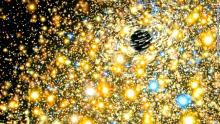Black holes are areas that were only postulated about in the days of Albert Einstein a half century ago. In the subsequent decades astronomers and astrophysicists have located hundreds of these gravitational abysses. Simply described, they’re pockets of gravity so intensely powerful that they even swallow light that comes within their area of effect, giving them their characteristically “black” appearance. However, the two newest black holes that have been discovered are so immensely large and destructive that they’ve been given the head-scratching title “super massive”.
The first black hole, the one roughly the size of 9.7 billion suns, was located in a galaxy called NG3842. The larger of the two, found in NGC 4889, has the solar mass of 21 billion suns and sits in the middle of a galaxy 300 million light-years away. By comparison, the black hole in the middle of our own Milky Way galaxy has a solar mass of some 300 million suns. Harvard theorist Avi Loeb stated in Nature magazine that, “If we infer the existence of quasar black holes of ten billion solar masses at early cosmic times, we'd better find their counterparts in the present-day Universe." In other words, scientists were expecting to eventually find these cosmic monsters.
Quasars are essentially black holes so large, and the amount of mass so that they’re “sucking” in so vast, that when it is suddenly crushed together in the black hole it sends out a massively bright burst of energetic light across the cosmos. Anything capable of doing this would have to be huge, or “super massive”. One could think of the recently discovered black holes as “Qasar-capable”. At the beginning of the universe there was plenty of gas and floating mass to power Qasar’s brilliant flashes of light. However, as the universe has expanded there is less to power them, but the black holes that create them should, theoretically still be floating out there somewhere. As it turns out, it isn’t theoretical anymore.
